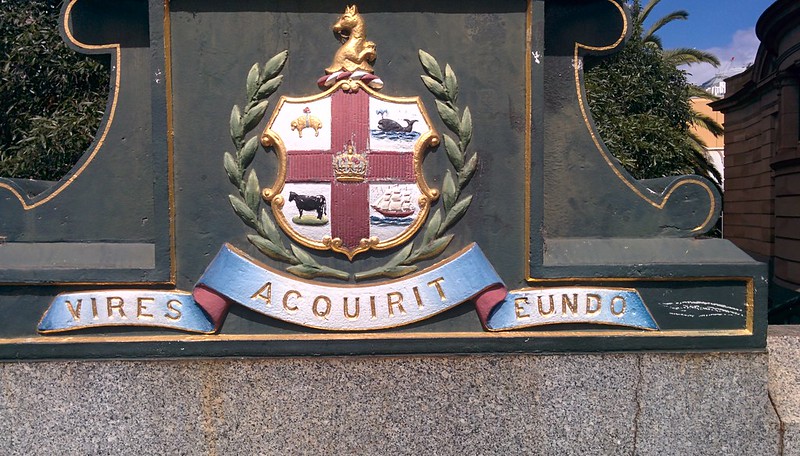NextGen Nature: Moving from Nature Exploitative to Nature Positive
By Gordon Noble
Research Director, Institute of Sustainable Futures, UTS Sydney
Everyday thousands of people walk along Princes Bridge in Melbourne, admiring the architecture of the bridge, and pausing to take photos of Melbourne’s skyline. The history of Melbourne is reflected on lamp posts on the bridge, with the City’s coat of arms capturing the things that Melburnians in the 1840s believed represented their economic prosperity: a sheep, a black bull, a ship, and a whale.

The extractive nature of Victoria’s early economy – of sheep runs to supply wool, commercial whaling to supply oil, beef to feed a hungry population, and shipping to bring in migrants and export raw materials – was something that even by the late 1800’s Victorians were beginning to reflect on. By 1884 the Field Naturalists’ Club of Victoria were describing the Wilson’s Promontory as a future “summer haunt of lovers of nature and lovers of scenery,”1 with the Royal Society of Victoria itself advocating for a national park.
From our vantage point today, it seems obvious that an economy based on extraction would ultimately face planetary limits. Whilst we are moving to a consensus that we can no longer extract our way to prosperity, we have yet to take the next step that business activities can be nature positive.
But there are some green shoots.
From exploitation to repair and regeneration
Nature positive, which the Australian Government defines as nature that is ‘repairing and regenerating rather than continuing to decline’,2 has become the common language that is uniting the different ways in which actions can drive better nature outcomes.
The focus on ‘nature positive’ came out of the Kunming-Montreal Global Biodiversity Framework (GBF), adopted in 2022 at the fifteenth meeting of the Conference of the Parties (COP 15) of the Convention on Biological Diversity (CBD).3 The GBF, which Australia is a signatory to, contributes to the achievement of the 2030 Agenda for Sustainable Development,4 and sets the global vision for biodiversity conservation and restoration by 2050.
The GBF commits parties to “30×30”, that is to protect at least 30% of the world’s land, freshwater and ocean ecosystems by 2030. The Australian Government has committed to the GBF, and set a national target.5
Reflecting the impact that business activities have on nature, a key area of focus of the GPF is to unlock private sector investment in nature. GBF Target 19, which seeks to mobilise US$200 billion per year for biodiversity, focuses on the preparation and implementation of national biodiversity finance plans, and the stimulating of innovative schemes such as green bonds and biodiversity credits.

Certificates for biodiversity projects
The Australian Government has taken biodiversity credits forward as a mechanism to flow finance into nature through the Nature Repair Act 2023, which provides a framework for a legislated, national, voluntary biodiversity market in Australia.6 The Act establishes that the Clean Energy Regulator (CER) is empowered to issue a biodiversity certificate for a ‘registered biodiversity project’, defined as personal property that is transmissible to other parties. In other words, a biodiversity certificate can be bought and sold in the same way other assets such as housing and shares in a company are.
The Act has yet to be implemented, with the Department of Climate Change, Energy, the Environment and Water (DCCEEW) currently developing technical methods that will define the eligibility of a biodiversity project to be issued with a biodiversity certificate.7
The establishment of biodiversity certificates as personal property does raise questions: what is the financial value of nature? Whilst there is broad consensus that nature has value, the idea that investors can be trusted to put a financial figure on that value is not universally believed.
A key question is how a biodiversity certificate market can be developed, which provides confidence to all stakeholders that nature outcomes are being delivered. To answer this, it is useful to understand two key features of a market: independent opinion, and trust.
The evolution of modern markets and brokers
The development of markets itself has been a foundation of economies and societies for centuries. In the United Kingdom, the Domesday Book of 1086 recorded sixty market towns. Historically, it was governments that directed the formation of market towns. The gathering of a market around a town square was not only convenient for traders but enabled local lords to control the activities of the market – and earn income from stallholders.
Recognising the potential for unethical practices, mediaeval market towns mandated a role for independent brokers. Not only did this provide matchmaking between buyers and sellers, but also played a role as intermediaries across a wide range of goods including salt, wine, horses, spices, and construction materials.8 The responsibility of brokers varied, but included informing the buyer of the quality of the goods being purchased. Importantly, brokers were not entitled to engage in trade themselves. Penalties for breaching council regulations included fines, loss of rights to broker, and imprisonment.
Independent research brokers have become a feature of all major stock exchanges providing market participants with their views on the value of a company. Increasingly, environmental, social, and governance (ESG) ratings have been a key feature of independent research.
Fraud triangles and market integrity
An added dimension to the efficient functioning of a financial market is trust. United States criminologist Dr. Donald Cressey examined the rationale behind establishing and enforcing rules for market integrity in 1953.9 Cressey interviewed 133 inmates in three penitentiaries, who had misused a position of financial trust. His resulting “fraud triangle”, which has become the core of financial markets, consisted of three components that work together to contribute to increasing the risk of fraud: (1) opportunity, (2) incentive, and (3) rationalisation. Cressey’s work has become the basis of independent regulators that enforce market integrity.
Whilst the establishment of biodiversity certificates issued through the Nature Repair Act 2023 establishes biodiversity projects as an asset that can be owned and traded by investors, it does not establish an efficient, functioning market. It will be up to market participants and stakeholders to ensure that happens. A key missing element is the provision of independent opinions on biodiversity certificates that supports confidence of those who may buy a biodiversity certificate as well as all stakeholders who have an interest in the development of biodiversity certificates to support nature outcomes.
What is the opportunity for Victoria?
The reality is that the Nature Repair Act 2023 will soon result in the issuance of biodiversity certificates as personal property. How can Victoria support the development of a market for biodiversity certificates that is based on integrity and trust and, in doing so, deliver nature positive outcomes? Supporting biodiversity scientists to provide independent opinions for biodiversity certificates is one way to help to build a market based on integrity and trust.
Two steps are proposed:
- Provide long term funding for the Biodiversity Council, with the objective of enabling it to provide independent opinions on biodiversity projects. This will integrate science into the functioning of a nature market and build stakeholder confidence on the nature outcomes delivered by biodiversity projects through the Nature Repair Act.
- City of Melbourne – get a new coat of arms that reflects Victoria’s ambition to be known for nature positive outcomes, not extraction.
–
Gordon Noble is a Research Director at the Institute for Sustainable Futures, University of Technology Sydney.
References:
- A History of Wilsons Promontory National Park, Victoria, Australia, Published electronically by the Victorian National Parks Association, May 2009, historyofwilsonspromontory.wordpress.com
- Environment Protection Australia legislation introduced to Parliament. (2024). DCCEEW. minister.dcceew.gov.au/plibersek/media-releases/environment-protection-australia-legislation-introduced-parliament
- Convention on Biological Diversity. (n.d.). GBF Home. UN environment programme. www.cbd.int/gbf
- United Nations. (2015). Transforming Our World: The 2030 Agenda for Sustainable Development. United Nations Department of Economic and Social Affairs. sustainabledevelopment.un.org/content/documents/21252030%20Agenda%20for%20Sustainable%20Development%20web.pdf
- DCCEEW. (2022). A New Global Biodiversity Framework: Kunming-Montreal Global Biodiversity Framework. DCCEEW. www.dcceew.gov.au/environment/biodiversity/international/un-convention-biological-diversity/global-biodiversity-framework
- Nature Repair Act 2023 (No.121) (Cth), www.austlii.edu.au/cgi-bin/viewdoc/au/legis/cth/num_act/nra2023155/s34.html
- DCCEEW. (2024). Methods for the Nature Repair Market. DCCEEW. www.dcceew.gov.au/environment/environmental-markets/nature-repair-market/methods-for-the-nature-repair-market
- Lars Boerner, Department of Economic History, London School of Economics, Economic History Working Papers, No. 242/2016, Medieval Market Making Brokerage Regulations in Central Western Europe, ca 1250-1700, June 2016.
- Cressey, D. R. (1953). Other People’s money: A study in the social psychology of embezzlement, Free Press






